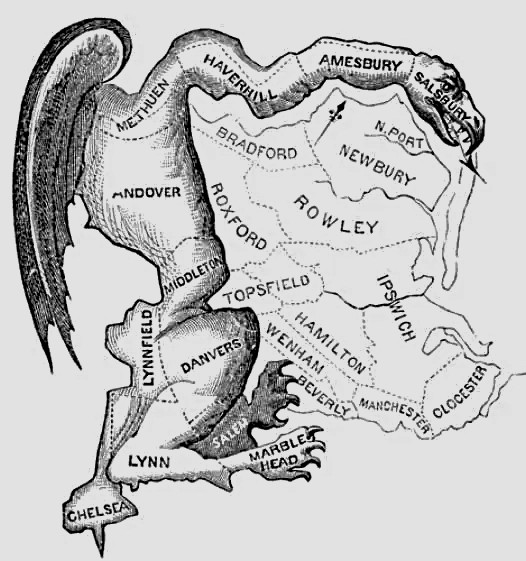Gerrymandering has entered the news again. It does so at least every 10 years, in the national context, and more frequently in one state or another. Its presence reminds people of a cockroach or a lizard slithering into civic life… and in fact, the term was birthed by a cartoon salamander back in 1812.

The Gerry-mander cartoon by Elkanah Tisdale (1771-1835), first published on March 26, 1812, in the ‘Boston Gazette,’ with this expanded version published in the ‘Salem Gazette’ on April 2, 1813. Source: electoral-reform.org.uk
Language, in relation to politics, can be a master or a servant. In the case of the Gerrymander, it is a wayward son; few people know its origin, its true utility, even its pronunciation. The word was coined as a portmanteau, a sarcastic reference to Massachusetts Governor Elbridge Gerry, whose surname carried a “hard” G. But “Jerry-mander” ascended and prevailed.
Gerry is a fascinating figure in American history. He was a signer of the Declaration of Independence, but he afterwards declined to sign the Constitution — arguing that it did not commit itself enough to personal liberty and protections. Partly based on his objections, the Bill of Rights was adopted as the first 10 amendments. He was a Federalist who largely endorsed a powerful executive branch, national bank, and central government, but he became a Democrat-Republican over what today might be termed libertarian concerns. In his tumultuous career, he served two terms in the House of Representatives, was his state’s governor, and later was elected vice president under James Madison.
When he was governor, Gerry very reluctantly approved a scheme to redraw the electoral map so towns friendly to his party, the Jeffersonian Democrat-Republicans, would comprise a majority in the legislature. Ironically, the party’s aims were largely accomplished, but Gerry later lost re-election himself. The manipulative nature of the unnatural electoral boundaries he called “highly disagreeable,” but he held his nose and signed the enabling legislation in 1812.
Elkanah Tisdale became one of America’s pioneer political cartoonists before there was a recognized profession; the craftsman and engraver saw the new district’s shape and rather tortuously perceived a resemblance to a salamander. (The previous American cartoonists, after this fashion of responding to events, were Paul Revere and Benjamin Franklin.) The Essex County state senate district became a sort of winged serpent-lizard, and found a home in the political lexicon, if not biology textbooks.
Political Cartoons As Political Discourse
The Gerrymander was not the first resident of a cartoon menagerie that has informed political discourse through the years. Franklin’s iconic cartoon was of a dismembered snake, each part representing a state, with the caption urging those states to “Join or Die.” In 1807, President Jefferson weakly advanced confused responses to French and British provocations while Napoleon and the Crown wrestled across Europe. One failed measure was the Embargo Act that inconvenienced neither the British nor the French, but bedeviled American merchants. A cartoonist drew a snapping turtle meant to embody the Embargo Act; “Ograbme,” the turtle’s name, is the palindrome of Embargo.
In the 1840s, about the time that Uncle Sam eclipsed Brother Jonathan as the cartoon symbol of the United States, a donkey appeared in broadsides as representative of the Democrat Party. Many think, rather, that Thomas Nast invented the icon, but he did make the elephant the everlasting symbol of the Republican Party in 1872. Other animals joined the visual lexicon through the years — an appropriately thirsty camel for the Prohibition Party; and perhaps most famously, a Bull Moose for Theodore Roosevelt’s Progressive Party in 1912.
The Gerrymander’s presence in dictionaries and its major place in history illustrate the vagaries of language. Gov. Gerry, as noted, opposed the scrambling of political eggs that, however, bear his name forever.
Electoral politics has a dark side that is as devoted to obfuscation as to enlightenment. Politicians aggressively muddy public discourse when “Equity” is confused with “Equality”; when budget deficits and increased taxes masquerade as “investments”; senility is defined as “the sharpest Biden ever”; and so forth.
Redistricting — A Constitutional Mandate
Similarly, it is in the eye of the beholder, not just scheming politicos, when Redistricting — a Constitutional mandate and temporal exercise — is called Gerrymandering. And vice versa. When representative government was agreed to, it was an automatic necessity to deal with changing populations and demographic shifts. It is a mathematical challenge, inevitably complicated by political correctness… much of which is legitimate. For instance, as districts are redrawn to, frankly, accommodate ideological or ethnic constituencies, such decisions might pander, or preserve, or eliminate, or create voter groups for good or ill. But not forever.
When it was required (Reynolds v. Sims, 1964) that districts must have equal-sized populations, and, later, in Thornburg v. Gingles, 1986, that “minorities” not be disaffected (say, aren’t conservatives minorities in some areas?), the muddy waters grew muddier. Such rulings resulted in political parties going extinct in some states, and ballooning in others. Were these judicial impulses good policy, or… Gerrypandering?
The Constitution requires a census (upon which redistricting is constructed) within every 10 years… but that curious word “within” is different than only once every decade, and when. President Trump has suggested another census ahead of 2030 with an eye toward redistricting, and Democrats upset by the fact that the expanding Hispanic population is proving to be conservative… have decided to howl about Gerrymandering instead of boosting redistricting, once among their pet projects.
Inherent in redistricting or Gerrymandering, take your pick, is the scramble for advantage beneath high-sounding principles and feigned outrage. Inevitable is the hypocrisy that cloaks the inconsistencies of politicians and the occasional commentator. If voters feel like pawns in these perennial rhubarbs, at least one class of folks are winners — the political cartoonists.
READ MORE from Rick Marschall:
John MacArthur: Helping Americans Count Angels on the Heads of Pins
Jimmy Swaggart, Pentecostal Leader and America’s Most Prominent Televangelist, Dies at 90
James A. Garfield: The Man Who ‘Stepped Down’ to Become President
Rick Marschall, a former political cartoonist, is the author of 75 books. He has written extensively on political cartoons for publications like The Columbia Journalism Review, Nemo magazine, and The Comics Journal. He was the associate editor of The World Encyclopedia of Cartoons (Chelsea House), for which he also wrote 350 entries.



![Man Arrested After Screaming at Senators During Big Beautiful Bill Debate [WATCH]](https://www.right2024.com/wp-content/uploads/2025/06/Man-Arrested-After-Screaming-at-Senators-During-Big-Beautiful-Bill-350x250.jpg)












